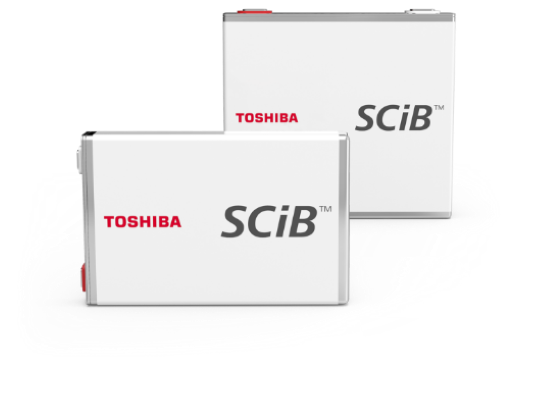
SCiB™ (Super Charge Ion Battery) is a lithium-ion battery that recharges to 80% capacity in 10 minutes and can be used for 20,000 charge/discharge cycles. Developed by Toshiba Corporation, SCiB may become the battery of choice for electric vehicles (EVs), industrial equipment, and grid energy storage.
Researchers have been working with other materials in the search for safer, and more energy-dense batteries. One material that is seen as an improvement on current Li-ion battery technology is lithium titanate (lithium titanium oxide or LTO) which replaces the graphite used in anodes. LTO has never gone mainstream because the batteries have provided lower energy density than Li-ion and have cost more to produce.
Toshiba claims that its new SCiBs address both energy density and cost. The anodes in its SCiBs are made from niobium-titanium oxide (NTO) which provides 350 Wh/l (Watt-hours per litre) energy density.
Electric batteries are rated two ways, either by Wh/l and Wh/kg (Watt-hours per kilogram). The higher the number, the more energy the battery stores by volume which appears as litres, or by weight which appears as kilograms. Where space volume is the limiting factor, battery energy density is measured in Wh/l. This is typically used in applications like EVs and grid storage. Where weight is limited such as in batteries used in small portable devices like laptops, tablets and smartphones, battery energy density is measured in Wh/kg.
SCiBs using NTO anodes provide twice the energy density of Li-ion batteries that use graphite anodes. In making this latest SCiB Toshiba has partnered with Sojitz, a Japanese aerospace company, and CBMM, a Brazil-based niobium miner. The three companies recently unveiled in Brazil a Volkswagen-designed electric bus powered by SCiBs. A June 19, 2024 press release describes the E-bus and its capabilities. The three companies intend to mass produce SCiBs with the first commercial EVs using them coming to the market in 2025.
Besides energy density, what makes SCiB technology attractive?
- SCiBs provide a low risk of fire or explosion and are therefore a better choice in applications requiring high levels of safety and reliability such as EVs and grid storage.
- SCiBs after 20,000 charge and discharge cycles retain better than 70% battery charge capacity.
- SCiBs can be charged to 80% capacity in 6 minutes, about the same amount of time it takes to pump gas or diesel into an internal combustion-powered vehicle.
- SCiBs are efficient with regenerative braking systems used by EVs, hybrids and trains.
- SCiBs are cold-tolerant, able to charge and discharge even in temperatures that drop to as low as -30 Celsius (-22 Fahrenheit).
- SCiBs provide drivers of EVs with reliable SOC (state of charge) data which replaces the fuel gauge used in internal combustion engine vehicles as a measure of driving range.
Toshiba sees SCiBs as ideal for use in EVs and hybrids, and for battery storage to stabilize power grids. The plan, currently, is to bring SCiBs in sufficient quantity to market in 2025 for use in commercial EVs and hybrids.








